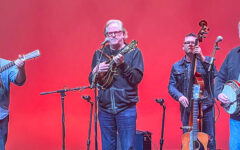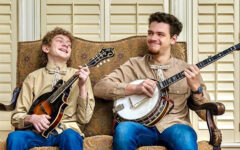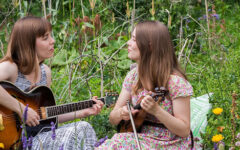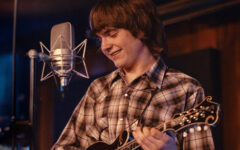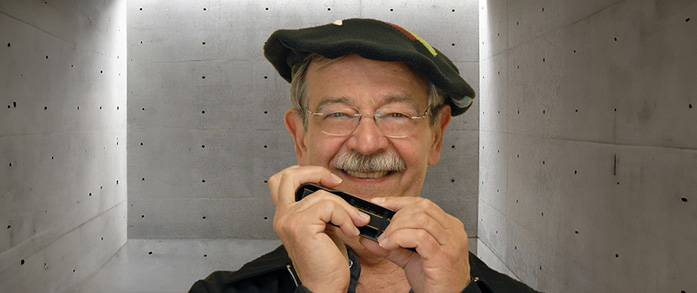
Southern California virtuoso harmonica player, teacher, composer, and session player David Naiditch has been part of the Los Angeles music scene for many years. His website bio says he “was tutored on the diatonic harmonica by the legendary blues icon, Sonny Terry. In the mid-1960s, I taught harmonica at the Ash Grove, a club that was the focal point of the Los Angeles folk music revival. Years later, I taught and performed at other venues in the Los Angeles area, such as McCabe’s Guitar Shop, Boulevard Music, the Coffee Gallery Backstage, and Viva Cantina.” He has seven albums of mostly bluegrass, swing, and gypsy jazz instrumentals, and is the foremost bluegrass harmonica player in the California scene today. He has played on albums by bluegrassers David Grier, Stuart Duncan, Richard Smith, Sierra Hull, Rob Ickes, Ron Block, Dennis Caplinger, Pat Cloud, and more…
Hi David. Has it been a busy summer of music for you? Where have you played?
Although I sometimes sit in with bands, these days I have little interest in performing, even less in touring. I like informal music jams and recording sessions. I attend a weekly bluegrass jam with some fine players. In May I did a lot of jamming at the Strawberry Music Festival and the Topanga Banjo Fiddle Contest, and I have many festivals lined up this year and next. I recently recorded a harmonica track for Jim “Kimo” West that included a fiddle track by Gabe Witcher, and recorded a Sunrise on the Guinea Farm with guitarist extraordinaire, Richard Smith.
Talk about your Bluegrass and Swing Instrumentals album. How did it come about?
I have 7 instrumental albums spanning 19 years, 6 of which were professionally produced by Eric Uglum at his New Wine Sound Studio & Mastering Lab in Apple Valley. Most of these albums feature bluegrass with a smattering of swing and Gypsy jazz, but one, “Douce Ambiance: Gypsy Jazz Classics,” is entirely Gypsy jazz. My latest album, “David Naiditch Plays Bluegrass and Swing Instrumentals,” includes 4 bluegrass and 8 swing tunes. This album was remotely recorded at the height of the COVID pandemic, and I never needed to meet anyone face-to-face. The musicians participating on this project recorded in studios from Nashville (David Grier and Stuart Duncan) to Utah (Jake Workman) to Germany (Joscho Stephan). I was very pleased with the result. Thanks to Eric, it sounds like we are all playing together in the same room. Overall, I’ve been very fortunate to have recorded with so many of my favorite musicians. For bluegrass: Stuart Duncan, Sierra Hull, Rob Ickes, Jake Workman, Dennis Caplinger, Pat Cloud, David Grier, Christian Ward, and Ron Block. For Gypsy jazz and swing: Joscho Stephan, Gonzalo Bergara, Jason Anick, Rob Hardt, Richard Smith, Ray Bergstrom, Aaron Till, and Steve Trovato. I find I play my best when challenged by these world-class virtuosos.
Are there a lot of people you play with who are equally proficient in both swing and bluegrass?
Yes. I’ve found that my favorite bluegrass instrumentalists also play great swing. I was especially surprised when I started recording with Jake Workman in 2014 when few people knew him. (That all changed a year later when Jake joined Ricky Skaggs’s Kentucky Thunder and was featured on the cover of the May/June 2015 issue of Flatpicking Guitar Magazine.) Jake’s solos weren’t just clean, forceful, and fast, his choice of notes was brilliant and often musically sophisticated. Even my professional jazz musician friends were extremely impressed with Jake and would say things like, “No bluegrass musician would have thought of that.” Unknown to me at the time, Jake received a degree in jazz guitar performance from the University of Utah.
Do you play much blues harmonica?
No longer. When I started playing music in junior high school, I played fingerpicking guitar and the blues harp. I took lessons from the country blues harmonica legend, Sonny Terry, and a bit later taught blues harmonica at the Ash Grove in Los Angeles right after Taj Mahal gave up teaching there. Today, though, I get a lot more enjoyment playing the chromatic harmonica that has all the notes and can be played in any key. The chromatic harmonica, however, can’t get the chugging chord effects and raw wailing sound of the blues harp. But I sometimes play the chromatic on jazzy blues, the type jazz musicians play.
Bluegrassers are not always the most welcoming to a harmonica in their jam. What is your approach to entering a jam at a bluegrass festival?
Harmonica players at bluegrass festivals are about as welcome as the mosquitoes that come out to feast. I hate to say this, but most harmonica players I’ve seen at bluegrass festivals don’t follow bluegrass jamming etiquette and step on everyone’s solos. Few can play melodically, but just play blues riffs over the chord changes. On the other hand, I’ve been jamming at bluegrass festivals for so many years that I’m almost always recognized and welcomed. As a chromatic harmonica player who can play the melody lines, I’m widely regarded as a singular anomaly. The chromatic harmonica is very difficult to play well, and the few who have mastered it play jazz, classical music, or pop, but certainly not bluegrass.
Of course, some bluegrass traditionalists define bluegrass according to the types of stringed instruments that have traditionally been used. They reject the use of non-traditional instruments such as a cello, harmonica, ukulele, or harpsichord, no matter how well such instruments are played. I love teasing such purists by showing videos of Eddie Barbash playing bluegrass and old time on the saxophone with folks such as Sierra Hull, Jacob Jolliff, Mike Barnett, Victor Furtado, and Andrew Vogts.
I’d imagine your deep fiddle-tune repertoire opens people up a bit after they hear you playing.
Yes. I can accurately play many bluegrass instrumentals, whether they are primarily played on the fiddle, guitar, banjo, or mandolin. I judge my playing by asking myself whether the notes I play are those a good bluegrass instrumentalist would play.
How is the chromatic harmonica different for fiddle tunes than the diatonic harmonicas?
Unlike the chromatic, the diatonic harmonica can play chordal rhythms that can often work well in old-timey fiddle tunes. I have in mind diatonic harmonica players such as Mark Graham and Dave Rice. For bluegrass fiddle tunes, however, I think the chromatic harmonica works far better. The chromatic can produce a sweet, fiddle-like sound and handle fast, intricate melodies. Since I use a C chromatic to play in all keys, I can deal with tricky chord changes and key transitions without having to quickly switch harmonicas. Because the chromatic provides all the notes without having to bend or over-blow, the timbre of each note isn’t dictated by the instrument, but is controlled by the player. I believe that keeping the same tone and timbre throughout a fiddle tune is often desirable.
What tunes can be played in both a gypsy jazz or bluegrass session?
I can think of only a few tunes that both bluegrass musicians and gypsy jazz musicians sometimes play. These are tunes such as Limehouse Blues (introduced to bluegrass by Don Reno), Sweet Georgia Brown (although in different keys), Bye Bye Blues, and Oh, Lady Be Good. However, the feel and choice of notes are quite different. Bluegrass typically doesn’t swing, uses simpler chords, and typically avoids jazzy notes. Bluegrass and gypsy jazz, however, do have a lot in common. Both genres use acoustic instruments that include the guitar, fiddle, and upright bass; both avoid drummers and other percussionists; both often have an ethnic folk sound that is very melodic; and both typically favor the sharp keys, avoiding the horn keys of Ab, Db, Eb, and Gb. When I attend gypsy jazz festivals such as Djangofest, Django in June, and Django a Gogo, there is often a subset of players who also play bluegrass.
Do you have many students and how can someone get in touch with you if they want lessons?
Today I seldom teach, although I certainly try to help those with questions. My email is davidnaiditch@charter.net. In the past, I taught harmonica at various community colleges, the Puget Sound Guitar Workshop, the Julian Fiddle Camp, McCabe’s Guitar Shop, and Boulevard Music. In every case, however, I just taught diatonic harmonica. With the diatonic, in just one lesson, a student can play a few tunes that do minimal damage to the listener’s ears. I’ve found the chromatic harmonica to be too difficult to teach in short group lessons. In addition to jumping to the correct hole and knowing whether to blow or draw, one must know whether to push the slide in or leave it out. These three independent actions must be precisely timed. In addition, these actions change, depending on the key. I’ve had a few good diatonic harmonica players taking private lessons, but they invariably find the chromatic too difficult and give up. Diatonic harmonica players are often at a loss when they first pick up a chromatic, and rarely have the patience to relearn the instrument at a beginner’s level.
Do you read music?
I rarely attempt to read music or use harmonica tablature, except when I occasionally teach. The great classical chromatic harmonica players read music well. This includes folks such as John Sebastian Sr., Tommy Reilly, and Cham-Ber Huang. The top harmonica studio musicians such as Tommy Morgan were great sight-readers. Many jazz harmonica players such as Toots Thielemans could read music. I’ve had little need for this skill, so I’m very bad at it. I almost exclusively play by ear.
What do you do when not playing music?
Before retiring, I worked as an aerospace engineer for 34 years. Before and after retiring, I’ve had many different interests besides playing the harmonica or guitar. I’ve written computer books and science articles, lectured on the latest scientific discoveries in the areas of physics and cosmology, made wood sculptures and paintings, and created digital artwork. In addition, for 24 years, my wife and I have hosted house concerts. These house concerts began in 1996 with the LA Guitar Quartet and ended when COVID hit. We were fortunate to host great musicians such as the Django Festival All-Stars, Mike Marshall, Dan Crary with Bill Evans, Hanneke Cassel and Rushad Eggleston, Noam Pikelny, Tim Kliphuis, Alasdair Fraser and Natalee Haas, Rob Ickes and Trey Hensley, Frank Solivan and Dirty Kitchen, Joscho Stephan, Rhythm Future Quartet, Special Consensus, Sideline, Jeff Scroggins and Colorado, Richard Smith with Brent Mason, David Grier, Pat Donohue, and the Quebe Sisters. Fortunately, Jeff Fleck has taken over our house concerts at his Crazy J Ranch at a beautiful mountaintop in Topanga Canyon. We also hosted science salons featuring scientists such as Kip Thorne, the Caltech physicist who got the Nobel Prize for his work on gravitational wave detectors, as well as physicists Lisa Randall and Janna Levin. Finally, we have hosted many bluegrass and swing jams at our house.
Talk about your instruments and gear.
I just use standard-tuned 12-hole chromatic harmonicas in the key of C. I use them right out of the box without any modifications. I especially like harmonicas from Seydel and Hohner. Hohner’s CX-12s are especially nice because I can perform open harp surgery without any special tools to remove popcorn kernels and any earwigs that may have entered. I attend acoustic jams, so I don’t need mics or amplifiers unless I’m on stage, in which case I use whatever Is provided.
Is there anything else you would like to say or plug?
To hear my music, check out my YouTube channel which currently has 103 videos.
To hear some of our house concerts and jam sessions, check this channel out.
My humor and digital creations can be found on Facebook.
My artwork can be seen there as well.
Thanks, David for your time, and hope to see you soon in a jam.

